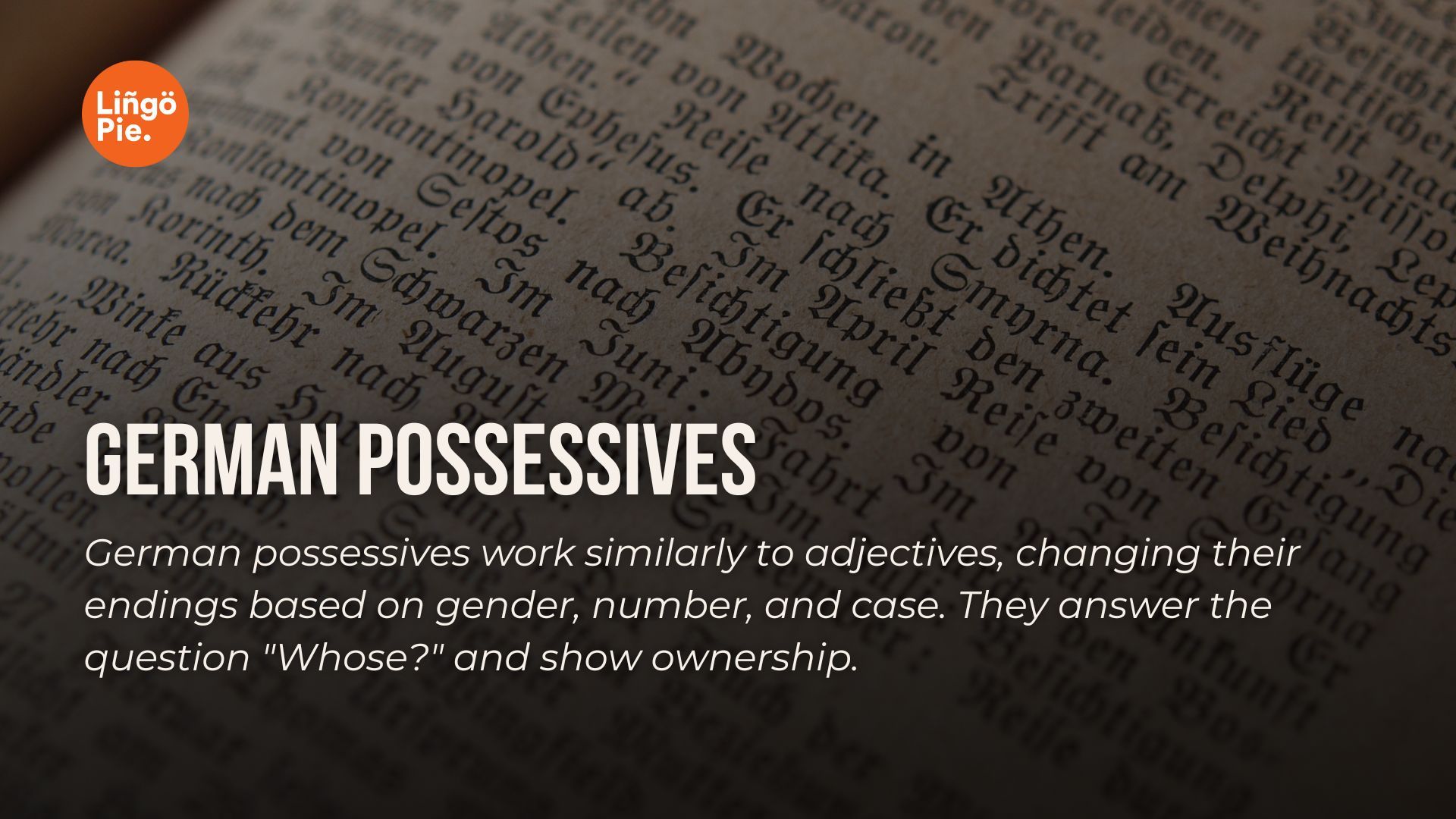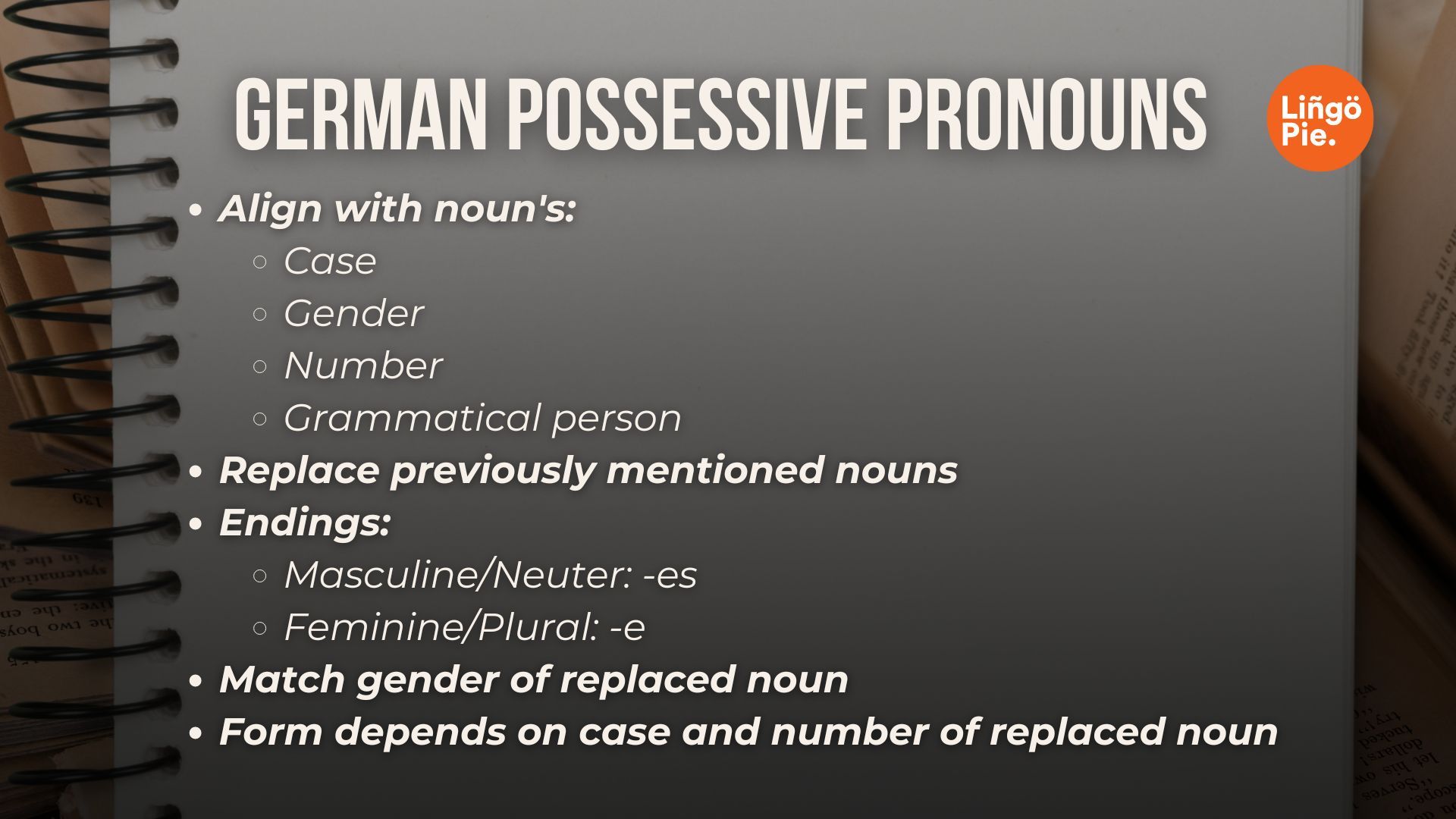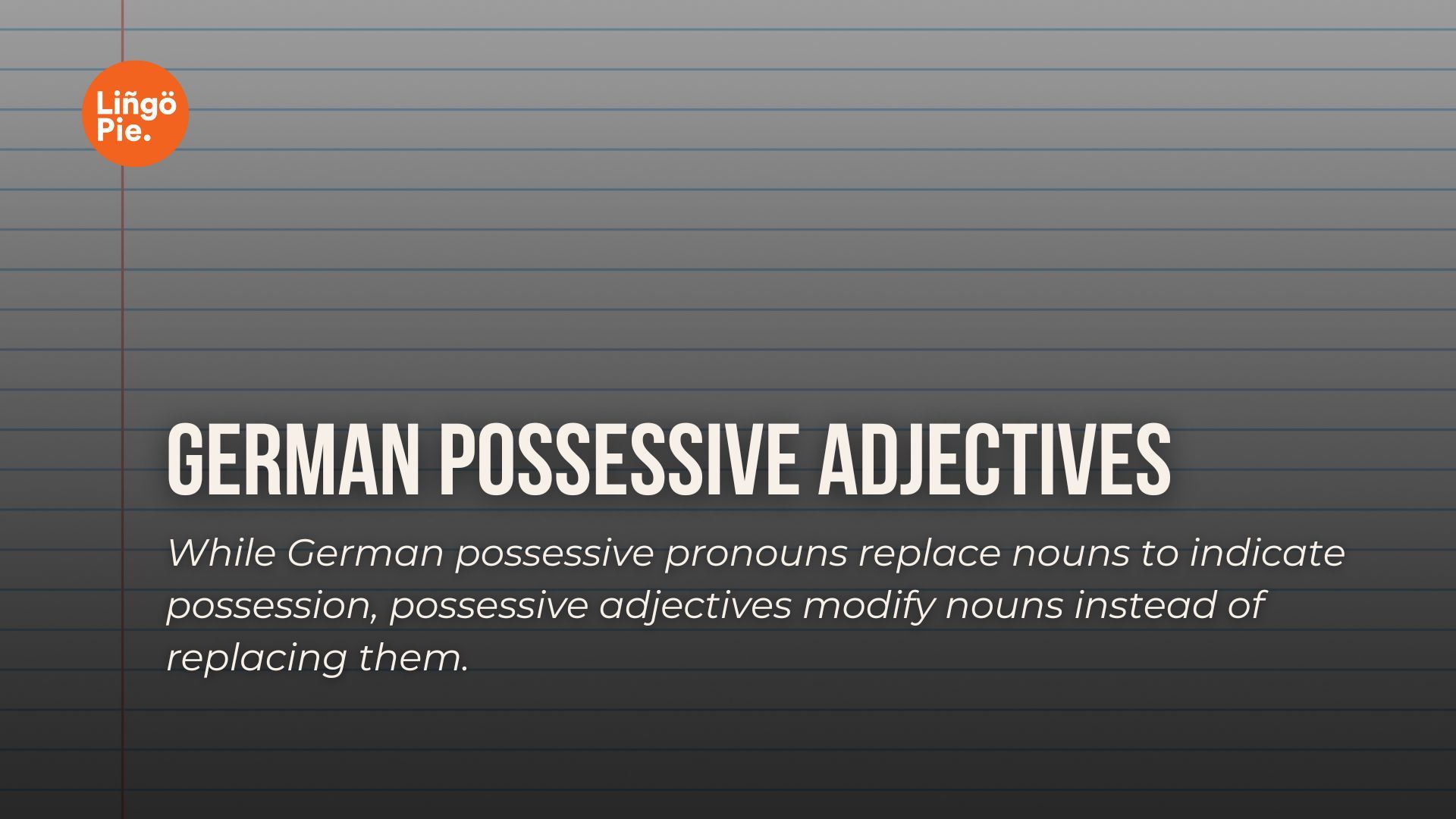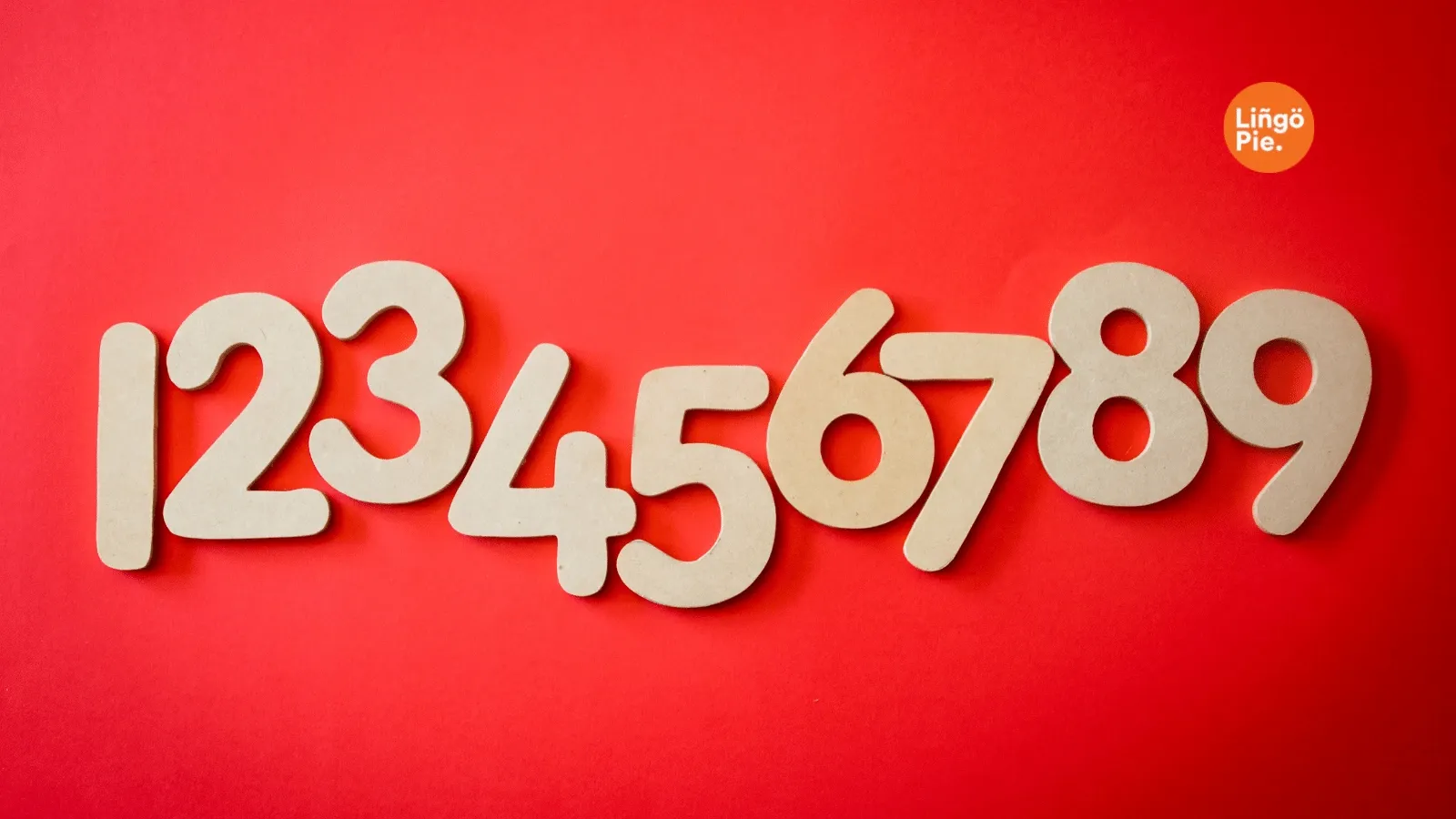Have you ever felt overwhelmed when trying to learn German, especially when it comes to possessive pronouns and adjectives? Don’t worry! Once you understand the basics and practice, you’ll be navigating the world of German possessive pronouns and adjectives with ease. Get ready to dive into the exciting world of German grammar and unlock the secrets to mastering possessive pronouns and adjectives.
In this blog post, we’ll guide you through the difference between German possessive pronouns and adjectives, the four German cases, and how gender and number play a significant role in determining the appropriate form and ending. By the end of this journey, you’ll be well-equipped to tackle German possessive pronouns and adjectives with confidence.
Key Takeaways
- Master German possessive pronouns and adjectives to confidently communicate in the language.
- Understand the genders, numbers, cases and grammatical persons of nouns for accurate usage.
- Utilize practice exercises & mnemonic devices to become a master of German grammar!

Understanding German Possessive Pronouns

Trying to learn German at home? If yes, then here's one thing you should know: Mastering German possessive pronouns and adjectives is important as they indicate possession and are not interchangeable.
Possessive pronouns take the place of nouns to show possession, while possessive adjectives accompany and modify nouns. For example, “meiner” is a German possessive pronoun that means “mine”. Using the correct possessive pronoun can help you avoid confusion and misunderstandings, ensuring that your message is clearly understood.
Accurate identification of cases and refinement of adjective endings, a key aspect of German grammar, can be achieved through the use of possessive pronouns. But before we delve into the specific rules and examples, let’s first explore the different types of possessive pronouns in German.
Types of Possessive Pronouns
There are three types of possessive pronouns in German, including the German possessive pronoun meiner:
| Person | Masculine | Feminine | Neuter |
|---|---|---|---|
| First person singular | mein (my) | meine (mine) | mein (my) |
| Second person singular | dein (your) | deine (yours) | dein (your) |
| Third person singular | sein (his) | ihre (her) | sein (its) |
These pronouns can be used as an indirect object in a sentence, adding more detail and nuance to your writing and helping you master German sentence structure.
For instance, “mein” (my) and “meine” (mine) are examples of first-person singular possessive pronouns in German. Similarly, “dein” (your) and “deine” (yours) are examples of second-person singular possessive pronouns. Lastly, “sein” (his), “ihre” (her), and “sein” (its) are examples of third-person singular possessive pronouns that you’ll encounter when you speak German.
Now that we’ve covered the types of possessive pronouns, let’s examine the basic rules for using them.

Basic Rules for Using Possessive Pronouns
The case, gender, number, and grammatical person of the German nouns all play a role in determining the form of German possessive pronouns. However, understanding the basic rules for using possessive pronouns can be simplified by following a few simple steps. Determining the case, gender, number, and grammatical person is key to mastering this concept.
An example would be how possessive pronouns replace a previously mentioned noun and must align with the gender of the noun they substitute. The form of the possessive pronoun also depends on the case and number of the noun it is replacing. Masculine and neuter nouns take an -es ending for the possessive pronoun, while feminine and plural nouns take an -e ending. In this context, understanding to which gender a noun belongs is crucial for proper usage of possessive pronouns.
With these rules in mind, let’s now turn our attention to the closely related possessive adjectives.

German Possessive Adjectives: A Close Relative
While German possessive pronouns replace nouns to indicate possession, possessive adjectives modify nouns instead of replacing them. This distinction is essential for accurate communication and understanding of the German language. For example, the possessive adjective for “your dog is black” in German is “dein”.
An effective way of learning possessive adjectives would be to use a chart listing all the possessive determiners with added extra letters at the ends. The English equivalents of German possessive adjectives are:
| English | German (Masculine) | German (Feminine) | German (Neuter) | German (Plural) |
|---|---|---|---|---|
| my | mein | meine | mein | meine |
| your | dein | deine | dein | deine |
| his/her/its | sein | seine | sein | seine |
| our | unser | unsere | unser | unsere |
| your (pl) | euer | eure | euer | eure |
| their | ihr | ihre | ihr | ihre |
Now that we’ve introduced possessive adjectives, let’s explore how to identify and apply them.
Identifying Possessive Adjectives
You can confidently identify possessive adjectives in German by selecting the correct pronoun stem and applying the appropriate ending based on the noun’s gender and case. For example, the possessive adjective for “I” is translated as “mein” (my), while “you” is translated as “dein” (your), and so on.
By familiarizing yourself with these characteristics, you’ll be able to quickly and accurately identify possessive adjectives in various contexts. This will help you improve your German sentence structure and overall language skills.
Applying Possessive Adjectives
While utilizing possessive adjectives, determining the noun’s gender and case being modified and using the appropriate ending is vital. This ensures that your message is clear and accurately conveys ownership or possession.
For a correct strong declension, add an ‘e’ between the possessive base-word and the declension, if it is any letter other than ‘e’. Using these tips, you’ll be able to effectively apply possessive adjectives in your German sentences, improving your communication and understanding of the language.
Examples:
My cat is playful.
- Meine Katze ist verspielt.
- "Meine" is the German possessive adjective corresponding to "my," indicating that the cat belongs to the speaker.
Their house is big.
- Ihr Haus ist groß.
- "Ihr" is the German possessive adjective indicating that the house belongs to a group of people other than the speaker.
Her book is on the table.
- Ihr Buch liegt auf dem Tisch.
- "Ihr" is the German possessive adjective showing that the book belongs to a female person other than the speaker.
Navigating German Cases with Possessive Pronouns
It can be challenging to navigate German cases with possessive pronouns. However, understanding the four cases (nominative, accusative, dative, and genitive) is essential for proper usage. The noun’s case is directly linked to the role the noun plays in the sentence, making it an exciting way to understand the language.
Pay close attention to the noun’s gender and number, context of the sentence, and used prepositions to correctly identify the case. Let’s explore some case-specific examples to illustrate this concept further.
Case-specific Examples
The form of possessive pronouns changes according to the case of the noun they replace. For instance, the possessive pronoun for the nominative case is “mein”, while the possessive pronoun for the accusative case is “meinen”. By understanding these variations, you’ll be better equipped to use possessive pronouns accurately in different cases.
Tips for Identifying the Correct Case
Examining the article and the noun’s ending can help determine the noun’s case. This will give you clues about the noun’s gender and case, allowing you to apply the appropriate possessive pronoun or adjective. Here is the table with the cases illustrated for the pronoun "mein":
| Case | Masculine | Feminine | Neuter | Plural |
|---|---|---|---|---|
| Nominative | mein | meine | mein | meine |
| Accusative | meinen | meine | mein | meine |
| Dative | meinem | meiner | meinem | meinen |
| Genitive | meines | meiner | meines | meiner |
For the notes:
- In cases where the chart specifies "(none)," we retain the possessive stem as is.
- For the possessive stem "euer," it drops the "e" after "u" when it takes an ending. For example, the singular feminine nominative form is "euer" + "e" = "eure," while the singular neuter nominative does not take an ending, so it remains "euer."
Declensions can also be a useful tool for understanding the noun’s role by looking at the ending of the noun and the context of the sentence. By mastering the use of declensions and understanding the various cases, you’ll be well on your way to confidently using German possessive pronouns and adjectives.
Gender and Number: The Key to Mastering German Possessive Pronouns
The appropriate form and ending of German possessive pronouns are determined by gender and number, which are essential for mastery. There are three genders of German nouns: masculine, feminine, and neuter. Learning the gender of a noun is key to constructing your German sentences accurately.
With this knowledge, you can better understand how possessive pronouns and adjectives change depending on the gender and number of the noun they replace. Let’s now take a closer look at the different endings for masculine, feminine, and neuter pronouns.
Masculine, Feminine, and Neuter Pronouns
Learning the variations in endings of masculine, feminine, and neuter pronouns, which depend on the case, is vital for accurate communication. For example, the possessive pronoun for masculine nouns is “mein”, while the possessive pronoun for feminine nouns is “meine”.
Understanding these different endings will help you use German possessive pronouns and adjectives more effectively, ultimately improving your overall language skills. By practicing and immersing yourself in the language, you’ll be able to master these concepts and communicate more confidently in German.
How to identify?
Identifying the case in German involves looking at the function of nouns, pronouns, articles, and adjectives within a sentence. Here are some general guidelines to help you identify the case:
Nominative Case (Subject):
- The noun or pronoun in the nominative case typically functions as the subject of the sentence. It answers the question "Who or what is performing the action?"
Accusative Case (Direct Object):
- The noun or pronoun in the accusative case usually functions as the direct object of the verb. It answers the question "Whom or what is the action directed toward?"
Dative Case (Indirect Object):
- The noun or pronoun in the dative case typically functions as the indirect object, indicating the recipient of the action. It answers the question "To or for whom or what is the action done?"
Genitive Case (Possession):
- The noun or pronoun in the genitive case typically shows possession or relationships. It answers the question "Whose? or To whom does it belong?"
Instrumental Case (Means or Tool):
- The instrumental case indicates the means or tool used to perform an action. It often appears with prepositions like "mit" (with) or "durch" (through). It answers the question "With what or by what means is the action carried out?"
Prepositions:
- Pay attention to the prepositions used in a sentence, as they often govern which case should be used. Different prepositions require specific cases, and this can be a helpful clue.
Word Endings:
- German nouns, articles, and adjectives change their endings depending on the case. Learn the declension patterns for each case to recognize the case based on these endings.
Context:
- Sometimes, the context of the sentence and the roles of various elements within it can help you identify the case. Look at the relationships between words in the sentence.
Remember that these are general guidelines, and there can be exceptions and nuances in certain situations. Practice and exposure to German sentences will improve your ability to identify cases accurately.
Practice Makes Perfect: Exercises and Tips for Improvement
In mastering German possessive pronouns and adjectives, practice is pivotal. By using exercises and learning strategies, you can improve your understanding and retention of these important grammar concepts. Resources such as Clozemaster offer grammar challenges, cloze-listening, and cloze-reading exercises to help you learn in context and practice your skills.
Additionally, taking possessive pronouns quizzes and practicing with mixed exercises can further test your knowledge and understanding. Let’s now explore some exercise examples and strategies for learning and retention.
Exercise Examples
Exercise examples offer an opportunity to use possessive pronouns and adjectives in various contexts, thereby solidifying understanding. By engaging with these exercises, you’ll be able to build your confidence in using German possessive pronouns and adjectives, ultimately improving your overall language skills.
With more practice, comfort and confidence in using German possessive pronouns and adjectives increase. So, don’t be afraid to challenge yourself and explore different resources and practice opportunities to enhance your understanding.
Learning German Grammar? Here check out our articles:



Strategies for Learning and Retention
Looking for similarities between words, noting the word endings, and utilizing mnemonic devices can help uncover patterns and formulas in German possessive pronouns and adjectives. Focusing on base words can also be beneficial, as you can look at the root of the word, break it down into its component parts, and use cognates to help identify words.
Language immersion can also be of immense help. Here are some ways to immerse yourself in the German language:
- Listen to German music
- Watch German films
- Read German books
- Practice speaking with native speakers
The more you immerse yourself in the language, the more natural and comfortable it will become for you.
Learn German with Lingopie
Lingopie is an innovative language learning platform that offers a unique and engaging way to master a new language through the power of entertainment. What sets Lingopie apart is its integration of foreign-language TV series and movies into the language learning experience. With Lingopie, learners can immerse themselves in captivating content while benefiting from interactive subtitles and language-learning tools. By simply clicking on unfamiliar words or phrases, users can access instant translations and definitions, effectively transforming their favorite shows into personalized language lessons.
This immersive approach not only makes language learning fun and enjoyable but also provides invaluable real-world context and cultural insights, making it a dynamic and effective way to achieve language proficiency. Whether you're a beginner or seeking to enhance your language skills, Lingopie offers a vibrant and effective way to reach your language learning goals.

Summary
In summary, mastering German possessive pronouns and adjectives is an essential skill for anyone learning the language. By understanding the difference between possessive pronouns and adjectives, familiarizing yourself with the different types, and learning how they change based on case, gender, and number, you’ll be well on your way to confidently using these grammar concepts.
Remember that practice makes perfect, and using exercises and learning strategies can help improve understanding and retention. So, keep practicing, immerse yourself in the language, and watch as your German language skills flourish!
Frequently Asked Questions
What are the 9 German pronouns?
With nine essential pronouns, learning the basics of German is a crucial step for all beginners. Let's explore these nine pronouns - ich, du, er, sie, es, wir, ihr, sie and Sie - and get ready to start speaking German! Pronouns are an important part of any language, and German is no exception. Ich, du, er, sie, es, wir, ihr, s
What is the difference between genitive and possessive in German?
In German, the genitive is used to indicate a connection between two nouns, while the possessive is used to denote possession of an object. The two forms have different ways of being constructed.
What are the possessive adjectives in German?
German possessive adjectives include mein (ich) for "my/mine", dein (du) for "your/yours" (singular), sein (er) for "his", ihr (sie) for "her/hers", sein (es) for "its", unser (wir) for "our/ours", euer (ihr) for "your/yours" (plural), and ihr (sie) for "their/theirs".
What is the difference between German possessive pronouns and adjectives?
German possessive pronouns take the place of a noun to indicate ownership, while possessive adjectives modify the noun instead.
What are the three genders of German nouns?
In German, nouns are categorized into three genders: masculine, feminine, and neuter.





![Learning French with French Immersion [A Guide]](/blog/content/images/2023/10/8246A174-5934-4522-AEE5-69CBE50362E9.png)
![The Cheat Code to Learn Japanese With Movies [For Beginners]](/blog/content/images/size/w1200/2023/10/Spanish-1.png)



